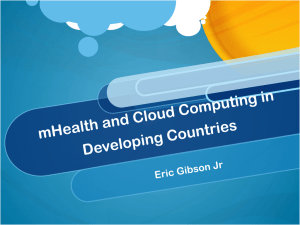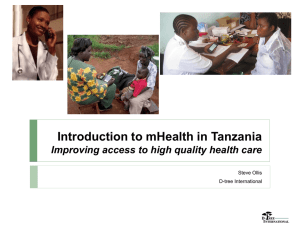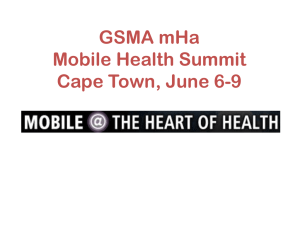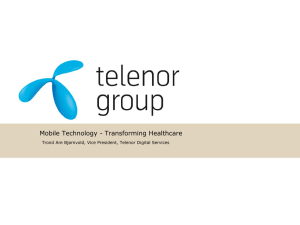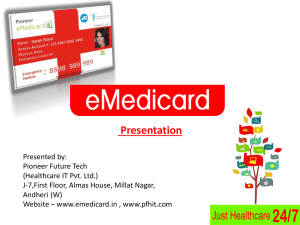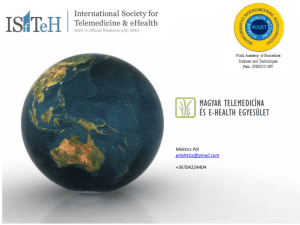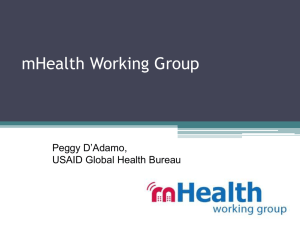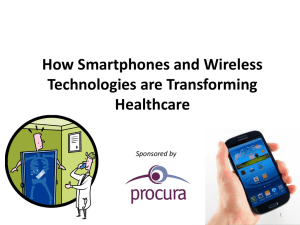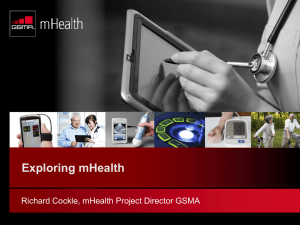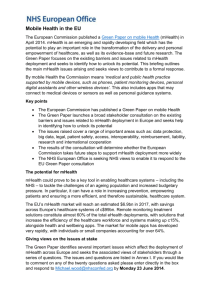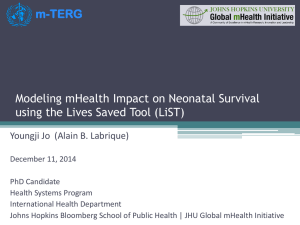eHealth to mHealth - The Eastern Cape ICT Summit
advertisement
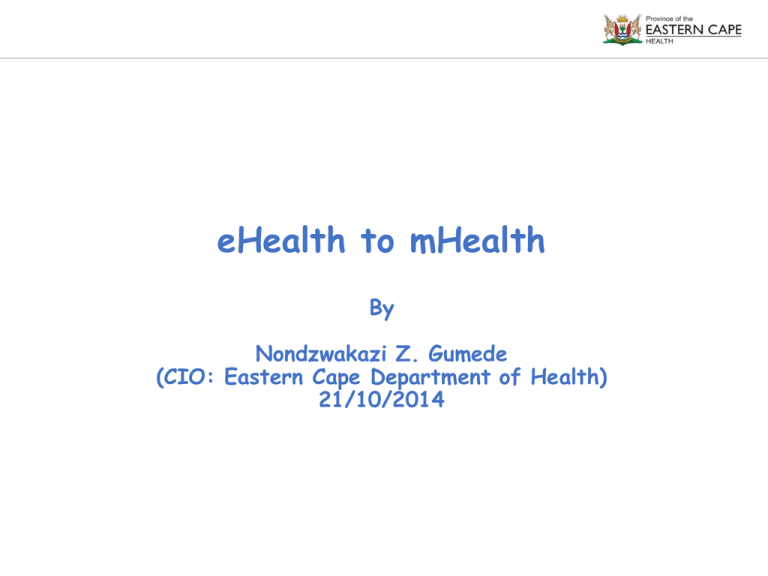
eHealth to mHealth By Nondzwakazi Z. Gumede (CIO: Eastern Cape Department of Health) 21/10/2014 Introduction • mHealth is an emerging term for medical and public health practice supported by mobile devices, such as mobile phones, patient monitoring devices, personal digital assistants (PDAs), and other wireless devices. • mHealth applications include the use of mobile devices in collecting community and clinical health data, delivery of health care information to practitioners, researchers, and patients, real-time monitoring of patient vital signs, and direct provision of care. • mHealth use mobile and wireless technologies to support the achievement of health objectives. • The widespread use of mobile phones is one reason why this practice is rapidly progressing. • An mHealth project that uses mobile phones to access data on HIV/AIDS rates for example would require an eHealth system in order to manage, store, and assess the data. Thus, eHealth projects many times operate as the backbone of mHealth projects. Rational for mHealth • According to the International Telecommunication Union, there were almost 6 billion mobile phones in use worldwide in late 2011. Mobile technology offers tremendous opportunities for the healthcare industry to address one of the most pressing global challenges: making healthcare more accessible, faster, better and cheaper. • Technologies such as electronic medical records, remote monitoring and communication platforms, etc. is in many ways the prerequisite for the flourishing of mHealth. Patient-centric, ‘care anywhere’ is becoming a reality. • mHealth will be a major factor in providing personal toolkits that will help manage predicted vulnerabilities, chronic illness, and episodic acute conditions. • Improvements in quality have been demonstrated by increased adherence to guideline-based care, enhanced surveillance and monitoring, and fewer medication-related errors, such as incorrect prescriptions involving the wrong drug, wrong dose or incorrect route of administration. Other areas that show improvements are efficiency and reduced costs related to utilization (reduced numbers of laboratory and radiology tests), improved drug dosing and decreased medication related adverse events. Personal history records have additional potential benefits to improve patient health and communication with providers. 6 Principles for mHealth • mHealth solutions have begun to embrace the following six principles: Interoperability – interoperable with sensors and other mobile/nonmobile devices to share vast amounts of data with other applications, such as electronic health records and existing healthcare plans. Integration – integrated into existing activities and workflows of providers and patients to provide the support needed for new behaviours. Intelligence – offer problem-solving ability to provide real-time, qualitative solutions based on existing data in order to realise productivity gains. Socialisation – act as a hub by sharing information across a broad community to provide support, coaching, recommendations and other forms of assistance. Outcomes – provide a return on investment in terms of cost, access and quality of care based on healthcare objectives. Engagement – enable patient involvement and the provision of ubiquitous and instant feedback in order to realise new behaviours and/or sustain desired performance. ECDoH Strategic Direction Business Drivers Strategic Goals National Health Council 10 point plan Functional quality driven Public Health System National Health Council 10 point plan Combat and reduce non-communicable disease and mental conditions Millennium Development Goals Improve and strengthen mother and child health services Millennium Development Goals Combat and reduce impact HIV/AIDS and TB Shortages in skilled healthcare workforce Enhance institutional capacity ECDoH Challenges • High population growth, a high burden of disease prevalence, low health care workforce, large numbers of rural inhabitants, and limited financial resources to support healthcare infrastructure and health information systems • Admissions take too long • Referrals not monitored • Duplicate prescriptions (double dipping & no stock planning) • Medication default e.g. TB Current Business ECDoH Challenges Drivers for mHealth • If mHealth succeeds in delivering such things as a greater focus on prevention, better monitoring of chronic conditions and patient-centred care, its impact will be dramatic. • The drivers of mHealth in each country are thus different. The three biggest attractions are cost reduction, convenience of access and ability to obtain otherwise unavailable information. • Cost is also the leading driver of mHealth for the public sector and doctors, followed by the opportunity to provide new services and to reach previously inaccessible patients. • The adoption of mHealth, if it is to be meaningful, must be part of a wider disruption of healthcare. Levels of Institutions Home (Community Health Worker, Mobile Clinic) (WBOT) District Hospital (GP, 24 Hrs) Clinic (Professional Nurse) Regional Hospital (Specialists) CHC (Professional Nurse, GP) Tertiary Hospital (T1: Provincial Tertiary, T2: Central, T3: National) (Specialist, Academic) Family Profile Information collected by Ward Based Outreach Teams to provide household profiles Girlfriend (25yo, unemployed) Father (64yo, R10,000pm, Alcoholic Daughter (25yo, unemployed) Son (8yo, TB) Daughter (7yo) Mother (60yo, Diabetic) Son (30yo, stays at home, HIV +ve) Son (5yo, HIV +ve) Daughter (15yo, @ Gr. 7) Patient Journey Patient visits mobile clinic Healthcare worker does prelim routine checks and refers patient to a district hospital The GP refers the patient to a regional hospital and prescribes some medication Patient is handed a referral slip & appointment card for xRays at a regional hospital Patient arrives at a regional hospital and presents UPN to admissions/info centre Patient is handed a ref. # and an appointment date & time The GP diagnoses the patient and find that the symptoms might be something more Patient is immediately sent to xRay department who are expecting the patient On arrival at the hospital the patient makes his way directly to admissions and presents his referral note Patient is sent to relevant section and waits for GP to see him. The GP logs onto the computer and types in UPN and adds notes and findings xRays are done based on GP’s notes and instructions The admissions clerks types in the Unique Patient Number (UPN) and the records appear, describing the referral and also schedules the required for the next steps xRays are scanned and stored in the system (incl. report) and the referring GP is notified. The GP then makes recommendation for further case analysis… mHealth Solution Recommendation Improve coordination and communication between caregivers to improve quality of care and patient experience mHealth Patient Perspective • mHealth will offer patients easier access to care and more control over their own health. • Locate nearby healthcare providers and schedule appointments. • Provide basic education and awareness by ward based out reach teams along with primary care and make quality healthcare reach millions who currently have no access to physicians. • mHealth involves triaged health information and advice via contact centres staffed by paramedics, physiotherapists, nurses, doctors and health advisers, using an IT platform with a structured query database to give an appropriate health response. • Upload their health readings (e.g. blood sugar count, BP readings, etc.) to the clinician through SMS and mobile applications, with an SMS text delivered back to the patient explaining the readings and advising whether further action is required. mHealth Healthcare Provider Perspective • Healthcare providers are buying into mobile technology because it can help meet some of their needs, such as monitoring patient compliance, accessing records and communicating with colleagues. One of the most popular medical apps, for example, is Medscape, a free service which provides the latest medical news and information about diseases and drugs. • While improvement of care is a bigger driver than simple convenience, healthcare providers hope that it will happen through streamlining, rather than re-inventing, existing systems. mHealth Allows Managing Patient Information Across the Care Continuum • Patient Relationship Management • Document management Advisory Services • Hospital Management Emergency Services Management BI & Analytics Planning & Forecasting • Depot Management Quick Wins • Some quick wins to be had, that will almost certainly come from the simpler, more boring things: Health call centres/health-care telephone helpline: Use of mobile phones by trained health professionals to provide health advice and triage services; Education and information: Use of mobile phones to provide citizens with education and information on health topics; Treatment compliance: Use of short message service (SMS) and other ICT applications by health services to send citizens reminder messages aimed at achieving medication compliance for themselves, their children, and other family members; Appointment reminders: Messages sent using mobile phones to make or attend an existing appointment, such as reminder messages for antenatal care; Citizen feedback regarding services: Use of ICT to allow citizens to provide feedback or complaints concerning health services; Community mobilization/health promotion campaigns: Use of mobile phones for health promotion or to alert new and expectant motcitizens of particular health campaigns; and Telemedicine/Teleconsultation: Consultation between health practitioners about patients by using mobile phones. mHealth Partnerships • The public sector, while seeking to optimise access and quality, is looking towards the private sector for innovation and efficiency. mHealth enables both sectors in this regard, helping to improve access and quality while at the same time providing dramatic innovation and cost reduction opportunities. • Development of a cadre of trained professionals, to facilitate the adoption of health information systems. In time, these professionals can provide a sustainable bridge to improved use of health information and most importantly, better health. Thank You
